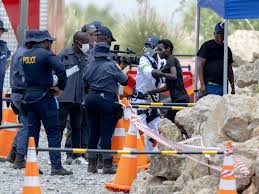
Rescue Operation Underway for Hundreds Trapped in South African Gold Mine

 :
| Updated On: 24-May-2025 @ 12:57 pm
:
| Updated On: 24-May-2025 @ 12:57 pmSHARE
Rescue efforts were ongoing in South Africa on Friday after more than 200 miners became trapped inside the Kloof gold mine for a second consecutive day. The mining company Sibanye-Stillwater, which operates one of the country’s deepest gold mines, confirmed that the miners were caught following what they described as a “shaft incident.” Despite the emergency, all workers were reported safe and were gathered at an assembly point within the mine, where they had access to food as rescue teams worked to evacuate them.
The company announced that a decision had been made for the miners to remain at the sub-shaft station until it was deemed safe for them to move to the surface, prioritizing their safety amid ongoing rescue operations. However, the exact number of trapped miners was unclear in the initial stages. News outlets reported approximately 260 miners trapped underground, while a spokesperson for Sibanye-Stillwater stated that 289 miners were inside the shaft.
The National Union of Mineworkers (NUM), representing the workforce at Kloof, expressed serious concerns about the incident. The union reported that the miners had been trapped for over 24 hours and criticized Sibanye-Stillwater for the delay in publicly acknowledging the incident. NUM spokesperson Livhuwani Mammburu emphasized the union’s worry about the lack of transparency, stating, “We are very concerned because the mine did not even make this incident public until we reported it to the media.”
The Kloof gold mine is located approximately 60 kilometers (37 miles) west of Johannesburg. It is notable for being one of the few mines in South Africa that extracts gold from some of the world’s deepest deposits, a factor that adds complexity and risk to mining operations and rescue efforts.
The incident has highlighted ongoing challenges in South Africa’s mining industry, where safety concerns and operational risks are significant due to the extreme depths and geological conditions of the mines. The Kloof mine’s shaft incident is a stark reminder of the dangers miners face daily and the critical need for effective emergency preparedness and response.
Sibanye-Stillwater has not detailed the exact nature of the “shaft incident,” but it triggered immediate emergency protocols, focusing on securing the trapped miners and initiating rescue operations. The company assured the public and families of the miners that all necessary measures were being taken to ensure the safe recovery of those affected.
This event has also sparked discussions about the transparency and communication protocols of mining companies during emergencies. The delayed reporting by Sibanye-Stillwater drew criticism from labor unions and media, emphasizing the importance of timely and clear communication to prevent panic and misinformation.
Meanwhile, families of the trapped miners gathered near the mine site, anxiously awaiting news of their loved ones. The local community and emergency responders worked together to support rescue efforts, with authorities closely monitoring the situation.
The South African government and mining safety regulators are expected to conduct investigations into the incident to understand its causes and prevent similar occurrences in the future. These investigations will also examine whether proper safety standards and protocols were followed leading up to the incident.
Overall, the Kloof mine shaft incident underscores the inherent dangers in mining at great depths and the critical need for robust safety measures. As rescue operations continue, the focus remains on the wellbeing of the trapped miners and providing timely updates to their families and the public.